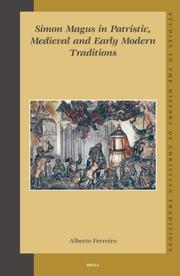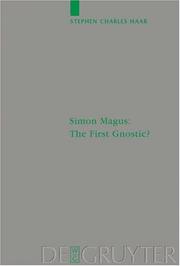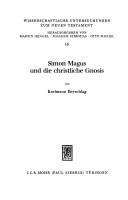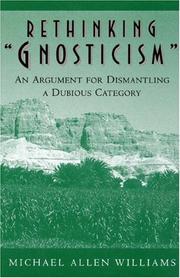| Listing 1 - 10 of 10 |
Sort by
|
Book
ISBN: 3525873514 9783525873519 Year: 1975 Volume: 1 Publisher: Göttingen: Vandenhoeck und Ruprecht,
Abstract | Keywords | Export | Availability | Bookmark
 Loading...
Loading...Choose an application
- Reference Manager
- EndNote
- RefWorks (Direct export to RefWorks)
Gnosticism --- Simon Magus --- #GROL:SEMI-22:21 --- Simon Magus. --- Cults

ISSN: 15735664 ISBN: 9004144951 9047415469 9789004144958 9789047415466 Year: 2005 Volume: 125 Publisher: Leiden: Brill,
Abstract | Keywords | Export | Availability | Bookmark
 Loading...
Loading...Choose an application
- Reference Manager
- EndNote
- RefWorks (Direct export to RefWorks)
The volume discusses the post-New Testament Simon Magus from the era of the Church Fathers beginning with Justin Martyr to the early modern era represented in a seventeenth century Baroque relief in the Cathedral of Oviedo, Spain. Sources consulted are artistic, theological texts, historical chronicles, sermons, hagiographies, vernacular literatures, biblical commentaries, and heresiologies. Topics explored are: Traditions and Historiography; Types of Simon Magus in Anti-Gnostic sources; a comparison of the Acts of Peter and the Passions of the Holy Apostles Peter and Paul ; Jerome and Vincent of Lérins on Simon Magus; the Nicolaitian heresy; the Fall of Simon Magus in the Church Fathers; Simon Magus, Dogs, and Simon Peter; Simon Magus in Irish and English medieval legends; Simon Magus, Nicolas of Antioch, and Muhammad; Vincent Ferrer and the canonical and apocryphal Simon Magus; Simon Magus in the Cathedral of León, Spain; Simon Magus in the Cathedral of Oviedo, Spain; and a full bibliographical inventory- 99 entries- of Simon Magus in artistic expression. The book is illustrated with about 28 artistic reproductions. The volume contains author and subject indexes and a full bibliography of works consulted.
Simon, --- Patristique --- Simon Magus --- Simon, - Magus, - 1st cent. --- Cultural influences --- Simon Magus,

ISBN: 3110176890 3111869601 3110898829 9783110898828 9783110176896 Year: 2003 Volume: 119 Publisher: Berlin ; New York : Walter de Gruyter,
Abstract | Keywords | Export | Availability | Bookmark
 Loading...
Loading...Choose an application
- Reference Manager
- EndNote
- RefWorks (Direct export to RefWorks)
Diese neue umfassende Studie zu Simon Magus verleiht der Erforschung der frühen Christenheit und den Fragen nach Herkunft und Wesen des Gnostizismus neuen Nachdruck. Der Autor geht dabei von der traditionellen Exegese von Act 8,5-24 - der ersten narrativen Quelle zu Simon - und den späteren Berichten antiker christlicher Schriftsteller aus. In einem Überblick zur Literatur der griechisch-römischen Antike wird der Einfluss der Begriffe "magisch" und "die Magier" auf die Wahrnehmung und Beschreibung Simons bestimmt. Schließlich bezieht der Autor sozialwissenschaftliche Erklärungsmodelle und moderne Bestimmungen von "Identität" ein und gibt damit der Diskussion um das Phänomen Simons neue Impulse. This latest comprehensive work on Simon Magus lends new impetus to the investigation of Early Christianity and questions surrounding the origin and nature of Gnosticism. Major contributions of this study include: (1), a departure from the traditional exegesis of Acts 8, 5-24 (the first narrative source of Simon), and the later following reports of ancient Christian writers; (2), an overview of the literature of Graeco-Roman antiquity to determine the contribution of "magic" and "the Magoi" in the development of perceptions and descriptions of Simon; and (3), the inclusion of social science explanation models and modern estimations of "identity", in a creative approach to questions surrounding the phenomenon of Simon.
Gnosticism --- 273.1 SIMON MAGUS --- Gnosis. Gnosticisme--SIMON MAGUS --- Theses --- 273.1 SIMON MAGUS Gnosis. Gnosticisme--SIMON MAGUS --- Simon, --- Simon Magus, --- Cults --- Gnosticism.
Book
ISBN: 9782701022895 2701022894 Year: 2019 Volume: 7 Publisher: Paris: Beauchesne,
Abstract | Keywords | Export | Availability | Bookmark
 Loading...
Loading...Choose an application
- Reference Manager
- EndNote
- RefWorks (Direct export to RefWorks)
L'un des plus grands mythes de notre littérature trouve son origine historique dans un personnage fantasque, mi-charlatan, mi-homme de science et de culture, le docteur Faust de Kundling. Mais les développements littéraires qui ont suivi sa mort singulière se sont appuyés sur différentes figures qui appartiennent au fonds commun de notre culture occidentale. Au premier rang d'entre elles, celle de Simon le Magicien, connue à travers les Actes des apôtres, la tradition hérésiologique (Justin, Irénée), et surtout le Roman pseudo-clémentin. C'est en effet dans cet ouvrage que l'auteur du premier récit sur Faust, le Faustbuch (1587), a puisé nombre des traits qu'il attribue à son anti-héros : le nom même de Faustus (bien attesté par ailleurs comme patronyme du magicien), les pratiques magiques et l'asservissement au démon, mais aussi la présence à ses côtés d'Hélène de Troie, la compagne de Simon. Cette confusion permit à l'auteur une nouvelle assimilation, celle de Faust avec le pape Alexandre VI Borgia, coupable de simonie. L'ouvrage retrace ce parcours littéraire, depuis les Actes des apôtres jusqu'au Faustbuch et quelques-uns des auteurs qui s'en sont inspirés (Marlowe, Goethe, Flaubert, Anatole France).
Simon, --- Faust, --- Faust --- In literature. --- Historia von Doctor Johann Fausten. --- Simon Magus --- Clemens I p. m. --- Pseudoclementina --- Simon, - Magus, - active 1st century. --- Simon, - Magus, - active 1st century - In literature. --- Faust, - -approximately 1540. --- Faust - (Legendary character) --- Simon, - Magus, - active 1st century

ISBN: 3161358724 9783161358722 Year: 1974 Volume: 16 Publisher: Tübingen: Mohr,
Abstract | Keywords | Export | Availability | Bookmark
 Loading...
Loading...Choose an application
- Reference Manager
- EndNote
- RefWorks (Direct export to RefWorks)
Gnosticism --- Simon Magus --- 273.1*1 --- #GROL:SEMI-22:21 --- Gnosis en Bijbel --- 273.1*1 Gnosis en Bijbel --- Gnose. --- Gnosis. --- Gnosticism. --- Gnosticisme. --- Handelingen der Apostelen (bijbelboek). --- Simon le Magicien. --- Simon, --- Simon Magus. --- Cults
Book
ISBN: 9783110240580 3110240580 9783110240597 1282716166 9786612716164 3110240599 9783110217315 3110217317 3110208083 9783110208085 9781282716162 6612716169 3110488493 Year: 2010 Volume: 96 Publisher: Berlin : De Gruyter,
Abstract | Keywords | Export | Availability | Bookmark
 Loading...
Loading...Choose an application
- Reference Manager
- EndNote
- RefWorks (Direct export to RefWorks)
Ausgangspunkt dieses in zweiter Auflage durchgesehenen und ergänzten Bandes ist ein Exkurs im Bellum Iudaicum des hier dem Ambrosius zugeschriebenen sog. Hegesippus über den Wettstreit des Petrus mit Simon Magus in Rom und die sich daran anschließende Christenverfolgung Neros, in der die Apostel Petrus und Paulus das Martyrium erleiden. Die Frage nach den Quellen dieser Episode und deren Historizität führt zu einer Überprüfung der "Schlüsselbeweise" für einen Aufenthalt des Petrus in Rom und der sonstigen literarischen Zeugnisse vom Neuen Testament bis in die Spätantike. Im Vordergrund stehen die apokryphen Apostelakten, der 1. Clemensbrief, Iustinus Martyr, Dionysios von Korinth, Polykarp von Smyrna und die Antihäretiker Hegesippus und Irenäus von Lyon. Die vermeintlich echten Briefe des Ignatius von Antiochien werden in den Rahmen christlicher und heidnischer Pseudepigrapha der Zweiten Sophistik eingeordnet, ihre Entstehungszeit auf das Jahrzehnt 170-180 festgelegt. Ein breites Kapitel ist philologischen Untersuchungen zur Datierung des 1. Clemensbriefes und der Spätschriften des Neuen Testamentes gewidmet. Am Ende steht eine kritische Edition (mit Übersetzung) der Martyrien des Petrus und des Paulus unter Berücksichtigung einer hier erstmalig eingeführten griechischen Handschrift, die ein bisher nicht bekanntes Selbstporträt des Paulus enthält.
Apocryphal Acts of the Apostles --- Criticism, interpretation, etc --- Peter, --- Paul, --- Simon, --- Homes and haunts --- Death and burial --- In literature --- Passio Petri et Pauli --- Martyrologies --- Actes apocryphes des Apôtres --- Martyrologes --- Commentaries --- History and criticism. --- Commentaires --- Histoire et critique --- Clement --- Pseudo-Ignatius, --- Passio Petri et Pauli. --- Acta Pauli / Martyrium Pauli. --- Acta Petri / Martyrium Petri. --- Apocryphal Acts of the Apostles --Criticism, interpretation, etc. --- Clement --I, --Pope. --First epistle of Clement to the Corinthians. --- Martyrologies --History and criticism. --- Paul, --the Apostle, Saint. --- Peter, --the Apostle, Saint --Death and burial. --- Peter, --the Apostle, Saint --Homes and haunts --Rome. --- Peter, --the Apostle, Saint --In literature. --- Peter, --the Apostle, Saint --Legends. --- Pseudo-Ignatius, --of Antioch. --- Simon, --Magus, --1st cent. --- Acts (Apocryphal books) --- Acts of the Apostles (Apocryphal books) --- Cephas, --- Pedro, --- Pietro, --- Simon Bar Jona, --- Simon Peter, --- Simon Petrus, --- Christianity --- Religion --- Philosophy & Religion --- History and criticism --- Petrus, --- Necrologies --- Apocryphal books (New Testament) --- Criticism, interpretation, etc. --- Christenverfolgungen. --- Erster Clemensbrief. --- First Clement. --- Ignatius of Antioch. --- Ignatius von Antiochien. --- Neues Testament. --- New Testament. --- Persecution of Christians. --- Simon Magus. --- RELIGION / Bible / General. --- Petrus --- Pierre --- Peter --- Acta Pauli --- Acta Petri --- Rom. --- Apocryphal Acts of the Apostles - Criticism, interpretation, etc. --- Petrus ap. --- Romae commoratio --- Peter, - the Apostle, Saint - Homes and haunts - Rome --- Peter, - the Apostle, Saint - Death and burial --- Peter, - the Apostle, Saint - In literature --- Peter, - the Apostle, Saint - Legends --- Paul, - the Apostle, Saint --- Simon, - Magus, - active 1st century --- Peter, - the Apostle, Saint
Book
ISSN: 18621112 ISBN: 9783110208085 3110208083 9786612372483 1282372483 3110217317 Year: 2009 Volume: 96 Publisher: Berlin: de Gruyter,
Abstract | Keywords | Export | Availability | Bookmark
 Loading...
Loading...Choose an application
- Reference Manager
- EndNote
- RefWorks (Direct export to RefWorks)
Ausgangspunkt dieses Bandes ist ein Exkurs im Bellum Iudaicum des hier dem Ambrosius zugeschriebenen sog. Hegesippus über den Wettstreit des Petrus mit Simon Magus in Rom und die sich daran anschließende Christenverfolgung Neros, in der die Apostel Petrus und Paulus das Martyrium erleiden. Die Frage nach den Quellen dieser Episode und deren Historizität führt zu einer Überprüfung der "Schlüsselbeweise" für einen Aufenthalt des Petrus in Rom und der sonstigen literarischen Zeugnisse vom Neuen Testament bis in die Spätantike. Im Vordergrund stehen die apokryphen Apostelakten, der 1. Clemensbrief, Iustinus Martyr, Dionysios von Korinth, Polykarp von Smyrna und die Antihäretiker Hegesippus und Irenäus von Lyon. Die vermeintlich echten Briefe des Ignatius von Antiochien werden in den Rahmen christlicher und heidnischer Pseudepigrapha der Zweiten Sophistik eingeordnet, ihre Entstehungszeit auf das Jahrzehnt 170-180 festgelegt. Ein breites Kapitel ist philologischen Untersuchungen zur Datierung des 1. Clemensbriefes und der Spätschriften des Neuen Testamentes gewidmet. Am Ende steht eine kritische Edition (mit Übersetzung) der Martyrien des Petrus und des Paulus unter Berücksichtigung einer hier erstmalig eingeführten griechischen Handschrift, die ein bisher nicht bekanntes Selbstporträt des Paulus enthält.
Apocryphal Acts of the Apostles --- Criticism, interpretation, etc --- Peter, --- Paul, --- Simon, --- Homes and haunts --- Death and burial --- In literature --- Passio Petri et Pauli --- Apocryphal Acts of the Apostles -- Criticism, interpretation, etc. --- Clement I, Pope. -- First epistle of Clement to the Corinthians. --- Martyrologies -- History and criticism. --- Passio Petri et Pauli. --- Peter, the Apostle, Saint -- Death and burial. --- Peter, the Apostle, Saint -- In literature. --- Peter, the Apostle, Saint -- Legends. --- Peter, the Apostle, Saint --Homes and haunts -- Rome. --- Peter, the Apostle, Saint. --- Pseudo-Ignatius, of Antioch. --- Martyrologies --- Religion --- Christianity --- Philosophy & Religion --- History and criticism --- 262.13 PETRUS --- Pausschap. Heilige Stoel. Vaticaan. Paus als soeverein--PETRUS --- 262.13 PETRUS Pausschap. Heilige Stoel. Vaticaan. Paus als soeverein--PETRUS --- Necrologies --- Acts (Apocryphal books) --- Acts of the Apostles (Apocryphal books) --- Apocryphal books (New Testament) --- Clement --- Pseudo-Ignatius, --- Simon Magus, --- Ignatius, --- Cephas, --- Pedro, --- Petrus, --- Pietro, --- Simon Bar Jona, --- Simon Peter, --- Simon Petrus, --- Pavel, --- Pavol, --- Paulus von Tarsus, --- Paulos, --- Pōghos, --- Paweł, --- Paweł z Tarsu, --- Būlus, --- Pablo, --- Paulo de Tarso, --- Paolo di Tarso, --- Pál, --- Apostolos Paulos --- Saul, --- القديس بولس الرسول --- بولس، --- 사도바울 --- Death and burial. --- In literature. --- Paulus, --- Pawełm --- Paulo, --- Paolo, --- Apostles. --- Petrus --- Pierre --- Peter --- Disciples, Twelve --- Christian saints --- Apostolic succession --- Acta Pauli --- Acta Petri --- Acta Pauli / Martyrium Pauli. --- Acta Petri / Martyrium Petri. --- Rom. --- Apocryphal Acts of the Apostles - Criticism, interpretation, etc --- Petrus ap. --- Romae commoratio --- Peter, - the Apostle, Saint - Homes and haunts - Rome --- Peter, - the Apostle, Saint - Death and burial --- Peter, - the Apostle, Saint - In literature --- Peter, - the Apostle, Saint - Legends --- Paul, - the Apostle, Saint --- Simon, - Magus, - active 1st century --- Christian Persecutions (Antiquity). --- First Epistle of Clement. --- Ignatius of Antioch. --- New Testament (Dating). --- Simon Magus. --- Peter, - the Apostle, Saint

ISBN: 9780691097664 0691097666 1400850851 0691018162 1306408911 Year: 1976 Publisher: Princeton (N.J.): Princeton university press,
Abstract | Keywords | Export | Availability | Bookmark
 Loading...
Loading...Choose an application
- Reference Manager
- EndNote
- RefWorks (Direct export to RefWorks)
Jung's last major work, completed in his 81st year, on the synthesis of the opposites in alchemy and psychology.
Alchemy --- Alchemy. --- Metals, Transmutation of --- Philosophers' egg --- Philosophers' stone --- Stone, Philosophers' --- Transmutation of metals --- Chemistry --- Occultism --- Adam Kadmon. --- Albertus Magnus. --- Alchemical symbol. --- All things. --- Allegory. --- Allusion. --- Ambiguity. --- Analogy. --- Angelus Silesius. --- Anima mundi. --- Antimony. --- Apotheosis. --- Apuleius. --- Archetype. --- Asclepius. --- Astrology. --- Attis. --- Aurora consurgens. --- Avicenna. --- Azoth. --- Christianity. --- Chthonic. --- Church Fathers. --- Cognomen. --- Concupiscence. --- Consciousness. --- Consummation. --- Deity. --- Demiurge. --- Democritus. --- Dismemberment. --- Emblem. --- Emerald Tablet. --- Explanation. --- Fairy tale. --- Filius philosophorum. --- Firmament. --- God the Father. --- God. --- Good and evil. --- Hermes Trismegistus. --- Illustration. --- Incarnation. --- Incorruptibility. --- Individuation. --- Kabbalah. --- Kenosis. --- Literature. --- Manichaeism. --- Meister Eckhart. --- Moralia. --- Multitude. --- Mysterium Coniunctionis. --- Naassenes. --- Neurosis. --- Nicolas Flamel. --- Nigredo. --- Nous. --- Novum. --- Ostanes. --- Parable. --- Paracelsus. --- Phenomenon. --- Philosopher. --- Philosophy. --- Physis. --- Prima materia. --- Pseudonym. --- Psychic. --- Psychology and Alchemy. --- Psychology of the Unconscious. --- Psychology. --- Putrefaction. --- Pythagoreanism. --- Religion. --- Rite. --- Rubedo. --- Simon Magus. --- Spirituality. --- Sulfur. --- Symptom. --- The Other Hand. --- The Philosopher. --- The Various. --- Theology. --- Thomas Aquinas. --- Thought. --- Tincture (heraldry). --- Treatise. --- Turba. --- Unconsciousness. --- V. --- Vinegar. --- Wickedness. --- World. --- Writing. --- Yesod. --- Yin and yang. --- Zohar.

ISBN: 0691005427 0691011273 1400822211 1282753193 9786612753190 1400813832 9781400822218 1400808537 9780691011271 9781400808533 9781282753198 9781400813834 Year: 1996 Publisher: Princeton, N.J. : Princeton University Press,
Abstract | Keywords | Export | Availability | Bookmark
 Loading...
Loading...Choose an application
- Reference Manager
- EndNote
- RefWorks (Direct export to RefWorks)
Most anyone interested in such topics as creation mythology, Jungian theory, or the idea of "secret teachings" in ancient Judaism and Christianity has found "gnosticism" compelling. Yet the term "gnosticism," which often connotes a single rebellious movement against the prevailing religions of late antiquity, gives the false impression of a monolithic religious phenomenon. Here Michael Williams challenges the validity of the widely invoked category of ancient "gnosticism" and the ways it has been described. Presenting such famous writings and movements as the Apocryphon of John and Valentinian Christianity, Williams uncovers the similarities and differences among some major traditions widely categorized as gnostic. He provides an eloquent, systematic argument for a more accurate way to discuss these interpretive approaches. The modern construct "gnosticism" is not justified by any ancient self-definition, and many of the most commonly cited religious features that supposedly define gnosticism phenomenologically turn out to be questionable. Exploring the sample sets of "gnostic" teachings, Williams refutes generalizations concerning asceticism and libertinism, attitudes toward the body and the created world, and alleged features of protest, parasitism, and elitism. He sketches a fresh model for understanding ancient innovations on more "mainstream" Judaism and Christianity, a model that is informed by modern research on dynamics in new religious movements and is freed from the false stereotypes from which the category "gnosticism" has been constructed.
Gnosticism. --- Rome --- Religion. --- Gnosticism --- 273.1 --- 273.1 Gnosis. Gnosticisme --- Gnosis. Gnosticisme --- Religion --- Cults --- Rome - Religion --- Against the Galilaeans. --- Agrippa Castor. --- Anchorite. --- Anthropomorphism. --- Anti-Judaism. --- Antinomianism. --- Antipope. --- Apocalypse. --- Apocrypha. --- Apocryphon. --- Apostasy. --- Asceticism. --- Blasphemy. --- Borborites. --- Cainites. --- Catharism. --- Celibacy. --- Cerdo (gnostic). --- Cerinthus. --- Christian Identity. --- Christian fundamentalism. --- Christianity. --- Church Fathers. --- Clement of Alexandria. --- Consubstantiality. --- Contra Celsum. --- Creation myth. --- Demiurge. --- Demonization. --- Dialogue with Trypho. --- Divine Spark. --- Doctrine. --- Elohim. --- Epiphanes (gnostic). --- Epistle to the Laodiceans. --- Ernst Troeltsch. --- Exegesis. --- Exorcism. --- False prophet. --- God. --- Good and evil. --- Gospel of Eve. --- Gospel of Philip. --- Heresy of the Free Spirit. --- Heresy. --- Heterodoxy. --- Holy Book of the Great Invisible Spirit. --- Ideal type. --- Incorruptibility. --- Infidel. --- Irenaeus. --- Jews. --- Judaism. --- Judas Iscariot. --- Justification (theology). --- Justin Martyr. --- Manichaeism. --- Marcion of Sinope. --- Marcionism. --- Martyr. --- Metempsychosis. --- New religious movement. --- Nicolaism. --- Orthodox Judaism. --- Plotinus. --- Predestination. --- Problem of evil. --- Pseudo-Philo. --- Puritans. --- Pythagoreanism. --- Reform Judaism. --- Religious text. --- Renunciation. --- Sacred prostitution. --- Satan. --- Sect. --- Secularization. --- Self-denial. --- Sethianism. --- Sexual Desire (book). --- Sexual abstinence. --- Simon Magus. --- Skepticism. --- Sophia (Gnosticism). --- Spiritual marriage. --- Spirituality. --- Superiority (short story). --- Tertullian. --- The Other Hand. --- Theodicy. --- Theodotus of Byzantium. --- Theology. --- Thou shalt not commit adultery. --- Thou shalt not covet. --- Tractate. --- Wickedness. --- Writing. --- Zostrianos.
Book
ISBN: 0691031738 1306985366 0691603510 1400863112 9780691031736 Year: 1992 Publisher: Princeton (N.J.): Princeton university press,
Abstract | Keywords | Export | Availability | Bookmark
 Loading...
Loading...Choose an application
- Reference Manager
- EndNote
- RefWorks (Direct export to RefWorks)
Around the turn of the fifth century, Christian theologians and churchmen contested each other's orthodoxy and good repute by hurling charges of "Origenism" at their opponents. And although orthodoxy was more narrowly defined by that era than during Origen's lifetime in the third century, his speculative, Platonizing theology was not the only issue at stake in the Origenist controversy: "Origen" became a code word for nontheological complaints as well. Elizabeth Clark explores the theological and extra-theological implications of the dispute, uses social network analysis to explain the personal alliances and enmities of its participants, and suggests how it prefigured modern concerns with the status of representation, the social construction of the body, and praxis vis--vis theory. Shaped by the Trinitarian and ascetic debates, and later to influence clashes between Augustine and the Pelagians, the Origenist controversy intersected with patristic campaigns against pagan "idolatry" and Manichean and astrological determinism. Discussing Evagrius Ponticus, Epiphanius, Theophilus, Jerome, Shenute, and Rufinus in turn, Clark concludes by showing how Augustine's theory of original sin reconstructed the Origenist theory of the soul's pre-existence and "fall" into the body.Originally published in 1992.The Princeton Legacy Library uses the latest print-on-demand technology to again make available previously out-of-print books from the distinguished backlist of Princeton University Press. These editions preserve the original texts of these important books while presenting them in durable paperback and hardcover editions. The goal of the Princeton Legacy Library is to vastly increase access to the rich scholarly heritage found in the thousands of books published by Princeton University Press since its founding in 1905.
Church history --- Anthropomorphism --- Theodicy --- Fathers of the church --- Church controversies --- History of doctrines --- Origen --- Influence --- Christian heresies --- Christian sociology --- #GOSA:II.P.AU.1 --- #GOSA:II.P.AU.3 --- #GOSA:II.P.ORI.M --- 219 --- 276 =75 ORIGENES --- History --- Analogieën. Antropomorfisme (theodicee) --- Griekse patrologie--ORIGENES --- Origin. --- Church history - Primitive and early church, ca. 30-600 --- Anthropomorphism - History of doctrines - Early church, ca. 30-600 --- Theodicy - History of doctrines - Early church, ca. 30-600 --- Origen - Influence --- Ambrosiaster. --- Anathema. --- Anchorite. --- Apologetics. --- Apologeticus. --- Apostasy. --- Arian controversy. --- Arianism. --- Arius. --- Asceticism. --- Backsliding. --- Basil of Caesarea. --- Blasphemy. --- Book of Judges. --- Books of Kings. --- Caelestius. --- Celibacy. --- Church Fathers. --- Consubstantiality. --- Council of Ephesus. --- Criticism of Christianity. --- Damnatio memoriae. --- Damnation. --- De fide. --- Dogma. --- Donatism. --- Ecclesiastical jurisdiction. --- Elijah. --- Epistle to the Ephesians. --- Evagrius Ponticus. --- Excommunication. --- Exegesis. --- Exorcism. --- Ezekiel. --- Fall of man. --- False prophet. --- Fear of God. --- Gluttony. --- God. --- Golden calf. --- Good and evil. --- Heresiarch. --- Heresy. --- Heterodoxy. --- Homoiousian. --- Iconoclasm. --- Idolatry. --- Image of God. --- Jacob and Esau. --- John Chrysostom. --- John of Jerusalem. --- Jovinian. --- Justification (theology). --- Macarius. --- Manichaeism. --- Marcion of Sinope. --- Marcionism. --- Matthew 25. --- Maximilla. --- Melania the Elder. --- Metempsychosis. --- Monophysitism. --- Montanism. --- Natural evil. --- Nomina sacra. --- Origen. --- Outer darkness. --- Paganism. --- Panarion. --- Paschal. --- Paul of Samosata. --- Paulinus of Nola. --- Pelagianism. --- Pelagians (Quietism). --- Polemic. --- Predestination. --- Priscillian. --- Priscillianism. --- Psalm 1. --- Religion. --- Renunciation. --- Sabellianism. --- Sexual Desire (book). --- Simon Magus. --- Sin. --- Spiritual body. --- Spirituality. --- Subordinationism. --- Superiority (short story). --- Susanna (Book of Daniel). --- The City of God (book). --- The Righteous Men. --- The Sheep and the Goats. --- Theodicy. --- Theodore of Mopsuestia. --- Theodosius I. --- Theology. --- Treatise on the Resurrection. --- Vigilantius. --- Wickedness. --- Fathers of the church. --- Church controversies. --- Influence.
| Listing 1 - 10 of 10 |
Sort by
|

 Search
Search Feedback
Feedback About UniCat
About UniCat  Help
Help News
News